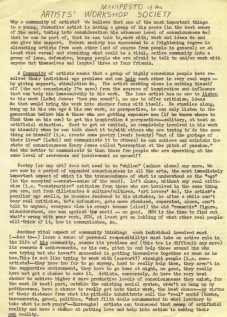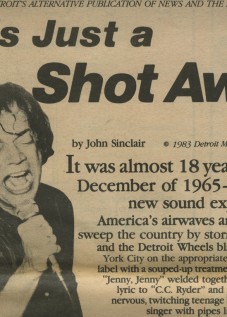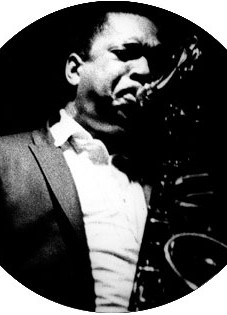Guerrilla : Weapon of Cultural Warfare
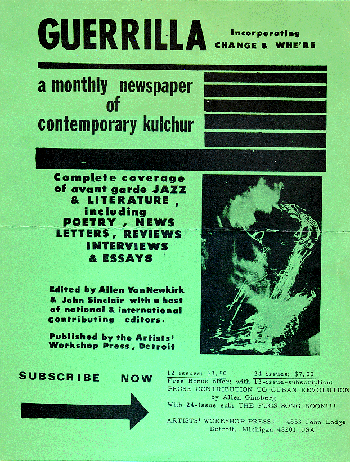
guerrilla magazine flyer, 1967
GUERRILLA: WEAPON OF CULTURAL WARFARE
or Blazing Poets, Paleocybernetics &
Voices on the Trans-Love Flame-out of Allen Van Newkirk
by Cary Loren, 2005
Dig! I mean value! Let’s talk! Words are value, instruction, action. And they’ve got to become social action. The radicalism lies from our words, alone.
–Charles Olson
Allen Van Newkirk was an anarchist poet with a fuck-off-world attitude. He was a tall, scruffy imposing figure on the Wayne State campus. Sporting long dark sideburns and an Elvis ducktail pompadour, hip among “greasers” —he fancied fast motorcycles, mini-skirts, handguns and dark Romantic poetry.
Van Newkirk was attracted to all forms of anti-art; surrealism, dadaism, situationism, avant-poetry and revolution-for-the-hell-of-it. He combined modern aesthetics with self-determination, carving out a unique poetics as the dangerous Detroit loner —an urban mad poet. He was unpredictable and manic—a figure few understood or cared to know, a self-made outsider poet.
The Fifth Estate editor Peter Werbe called Van Newkirk a volatile personality: a combination poet, anarchist and biker, “we both had the same motorcycle: a 300cc Honda. He would take crazy hairpin turns at high speed, taking chances that were totally insane. He’d command his current girlfriend to read The Story of O, his favorite erotic novel, which he could quote passages from by heart.”
Werbe recalled seeing him strike a tough-guy movie pose with one hand on his hip-holster pistol and another around a sexy girlfriend. In a letter to his online mailing list, Werbe stated, “Many of his projects were featured in the Fifth Estate, including his broadsides, and once, an attack on the venerable MC5, who were denounced as spectacularized commodities with a revolutionary veneer, much to the outrage of the band and their White Panther manager, John Sinclair. Decades ago, he disappeared into the mists of crime and madness and most of us dreaded hearing from him.”1
After John’s release from DeHoCo for a second possession of marijuana charge in ‘66, Van Newkirk, Sinclair and Grimshaw worked together to produce the visionary Detroit tabloid Guerrilla—using an oversized folded format that quickly became an influence on radical presses across the country. High speed Web-presses enabled low-cost newspapers to be mass produced cheaply in the thousands. Minimal spot color could be added, and it brought affordable speed and accuracy of reproduction into the hands of the people. The tabloid’s success quickly replaced the precious and difficult to produce hand-made mimeo zine.
 Guerrilla used a formula out of the playbook of Andre Breton: mixing humor, politics and music under the circus big top of surrealism and pop culture. Politically Van Newkirk was a guerrilla fighter: a one-man terror. Guerrilla and his later journals, flyers and broadsides were critiques of the hippie movement. He specialized in brilliant commentaries that were true revolutionary screeds. He briefly lived across the hall from John Sinclair’s basement apartment in the Forest Arms at Second and Forest, taking off for New York City soon after Guerrilla saw publication.
Guerrilla used a formula out of the playbook of Andre Breton: mixing humor, politics and music under the circus big top of surrealism and pop culture. Politically Van Newkirk was a guerrilla fighter: a one-man terror. Guerrilla and his later journals, flyers and broadsides were critiques of the hippie movement. He specialized in brilliant commentaries that were true revolutionary screeds. He briefly lived across the hall from John Sinclair’s basement apartment in the Forest Arms at Second and Forest, taking off for New York City soon after Guerrilla saw publication.
Guerrilla began life as a cultural review similar to Work, Change and other AWS publications. It had a firmer political international and artistic awareness. Its second issue was titled GUERRILLA Lovefare with a cover of bright red flames surrounding a Mexican Zapatista cartoon warrior shouting in a cartoon word-balloon: YOU CANNOT BUILD ENOUGH PRISONS… OR DIG ENOUGH GRAVES.. TO STOP THE GUERRILLA’S VIOLENCIA! VIVA LA REVOLUTION! Van Newkirk used shock and humor; illustrating bold graphic font techniques popular with Dada and surreal publications. Guerrilla aligned itself with Latin-American revolutionaries and black radicals. Guerilla made gripping statements in light of drug related police raids and arrests that recently plagued the workshop.
After the first issue was printed, Van Newkirk moved to New York staying with Andrei Codrescu and quickly fell in with a group of anarchists that formed Black Mask including Ben Morea and Dan Georgakas (formerly of Detroit). The group fractured off into the notorious Motherfuckers—which Van Newkirk took part in. The Motherfuckers caused a near violent confrontation with the MC5 when they were about to perform at the New York Fillmore—insisting they play a free benefit concert for the people.
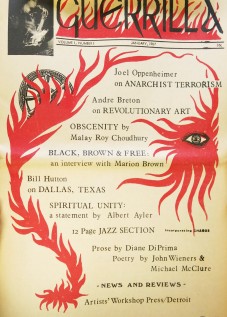
Guerrrilla Number 1 Vol. 1, editors John Sinclair and Allen Van Newkirk
Van Newkirk was an anarchist with no sympathy for hippies, slackers or others who tolerated them. His cause was for immediate revolution and the support of all revolutionaries worldwide. This caused a division inside the Workshop in regards to direction, ideology and the recognized growth of the “hippie” movement. Guerrilla began as a co-published, co-edited journal between Sinclair and Van Newkirk, but as the first issue was about to be published Van Newkirk announced a split from the Workshop firing Sinclair as editor. Despite that, their collaboration continued through all issues of Guerrilla, confirmed Sinclair. Van Newkirk’s position was stated in this editorial:
…the entire question eventually led to an editorial dispute over Guerrilla’s attitude toward what has been termed the “love generation’” or “Hippie” movement. It was the majority decision of the staff that it is the most important movement that has developed among middle class youth. However, we also felt that in many cases the movement has an immature, commercial, opportunist leadership, which for instance, the Diggers in SF have been at pains to point out. The staff also felt that it would not be finally, the decisive factor in the coming social, cultural, and spiritual revolution on the American Continent. “Love becomes the pass / the word taken intimately to combat / all the uses of language. So that learning / itself falls into disrepute.” –LeRoi Jones, or as Ed Sanders put it in a recent Barb interview: “…I don’t see how you could disrupt the war machine. That’s the way they’ve developed it through electronics and computers. The farther away an idea or an institution is from the human mind, the harder it is to dissolve it with love.”
With that editorial decision, John Sinclair resigned as co-editor and co-publisher of Guerrilla, although he will continue to contribute as Detroit correspondent. His resignation further aggravated our organization and financial crisis, which has taken these past three months to overcome. GUERRILLA will devote special issues to the international social and Cultural Revolution. The first special issue will appear next month, July 1st, devoted entirely to the Latin American Revolution.
There was strong international input in Guerrilla #1, with articles on the New Consciousness by Michael McClure, Black Dada by Tom Fiofori, Film Math and Music by Stan Brakhage, poetry by Diane DiPrima, Andre Codrescu and Robert Kelly, and Jazz music reviews by John Sinclair, an interview with Jazz altoist Marion Brown, a statement by Albert Ayler, a section of Joel Oppenheimer’s new play, and Andre Breton and Diego Rivera’s famous essay on “revolutionary art.”
Guerrilla had a roster of hip international contributing editors with contact listings from New York, Chicago, San Francisco, Philadelphia, Buffalo, Toronto, England, Washington D.C., Mexico City, Paris, Warsaw, Prague, Italy, Germany, India, Detroit and Palo Alto. It had the smart look and feel of something global, large and original. Art direction was handled by staff that worked out of its Detroit based office noted as: 4865 John Lodge, the same address as the Artists Workshop. Guerrilla was part of the international underground tabloid movement. And it was a contender.
An unassuming quarter page advertisement appeared in Guerrilla Vol 1, #2, for the first ten pamphlets of the Great Bear Pamphlet series: a group of manifestos, happenings, poems and performance pieces published by Dick Higgins’s fluxus, art-book publishing company: the Something Else Press. This first series included works by Alison Knowles, George Brecht, Claes Oldenberg, Al Hansen, Allen Kaprow, Ay-O, Oyvind Fahlström, Robert Filliou, Dick Higgins, Nam June Paik, Philip Corner, Wolf Vostell, Diter Rot, Jerome Rothenberg, Emmett Williams and Jackson Mac Low.
The Something Else Press books and pamphlets were sold at the Workshop and its bookstore outlets, making a clear connection to their support of the avant-garde arts and anti-art movements. Van Newkirk was moving in the direction of artists like George Maciunas and the Fluxus movement; becoming an expert at marketing, packaging and promoting.
Van Newkirk began to publish large format posters with his third issue—making these posters into tools for a revolution. It was a quick, theatrical and direct way to communicate to a mass audience. The poster was an art form embraced by youth culture, a natural expression linked within the underground press. Posters could be printed almost overnight and delivered cheaply worldwide. Many of the Guerrilla posters were inserted into issues of the Fifth Estate and passed along freely on the street. After several issues of Guerrilla, Van Newkirk was near bankruptcy and abandoned the tabloid for the immediacy of the political poster. Researcher Joel Kuszai assembled a descriptive survey of some of Van Newkirk’s posters from the Labadie Collection at the University of Michigan in Ann Arbor:
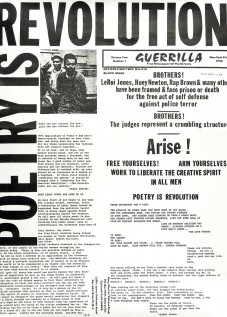
Guerrilla #2 Vol. 1, 1968
GUERRILLA POSTER—VOLUME 2 No. 1
“POETRY IS REVOLUTION” [TITLE] Guerilla, Free Newspaper of the Streets [MASTHEAD] New York City 1968 ARTIST & WRITERS MILITIA BLACK MASK
[THEN IN CENTERED TEXT]: BROTHERS! LeRoi Jones, Huey Newton, Rap Broan & many others Have been framed & face prison or death for the free act of self defense against police terror — Brothers! The judges represent a crumbling structure.
ARISE! FREE YOURSELVES! ARM YOURSELVES! WORK TO LIBERATE THE CREATIVE SPIRIT IN ALL MEN [WRITING BY A.V & POEM BY LEROI JONES]
GUERILLA POSTER—VOL. TWO NO. 2 NEW YORK CITY 1968
REVOLUTION and POETRY
“ART MATTERS LITTLE TO US, WE PROFOUNDLY HOPE THAT
REVOLUTION WARS, AND COLONIAL INSURRECTION WILL ANNIHILATE THIS WESTERN CIVILIZATION WHOSE VERMIN YOU DEFEND EVEN IN THE ORIENT… WE ASSERT THAT TWE HAVE FOUND TREASON AND WHATEVER ESLSE CAN HARM THE SECURITY OF THE STATE MORE RECONCILIABLE WITH POETRY THAN THE SALE OF LARGE QUANTITIES OF LARD TO A NATION OF PIGS AND DOGS.
{This piece collages quotes from Surrealists c. 1925?), Communist Manifesto, with Jones, Native American and international statements of resistance…as well as contemporary poetry (Dorn et al). The back of the poster (first one didn’t have anything on back) has longer poetry quotes from same basic foodgroup of poets, including Margaret Randall, Victor Hernandez Cruz, Victor Coleman, others) and also has an illustration – attributed to “CHE”? of a modified weapon designed to launch Molotov cocktails, etc.]
GUERILLA POSTER VOLUME TWO no. 3 – ELDRIDGE CLEAVER
a rule of thumb of revolutionary politics
is that no matter how oppressive the ruling class may be
no matter how impossible the task of making
Revolution
may seem
the means of making that
Revolution
are always near at hand.
“our purpose in entering the political arena is to send the jacksass back to the farm and the elephant back to the zoo.” Eldridge cleaver for president Minister of information/ black panther party
{THE BACK OF THE POSTER INCLUDES LONGER STATEMENTS – UNSIGNED? – AND THE BPP PLATFORM] WITH THE FOLLOWING QUOTES AND HEADLINES: “THE SPIRIT OF THE PEOPLE WILL BE STRONGER THAN THE PIG’S TECHNOLOGY”
“THE CONSUMER SOCIETY MUST DIE A VIOLENT DEATH”
“THINK OF YOUR DESIRES AS REALITIES”
GUERRILLA POSTER VOL. TWO NO. 4.
“YEAR OF THE HEROIC GURERILLA”
“CENTRAL COMMITTEE DADIST REVOLUTIONARY COUNCIL BERLIN 1919”
“CENTER FOR PALEOCYBERNETIC RESEARCH 1968”
[This poster includes a quote from Whitman’s Democratic Vistas and reprints “Respondez!” by Whitman, perhaps in full?]
Headline language (words POETRY DEMANDS and UNEMPLOYMENT are in approx 300pt type): POETRY DEMANDS THE INTRODUCTION OF PROGRESSIVE UNEMPLOYMENT THROUGH COMPREHENSIVE MECHANIZATION OF EVERY FIELD OF ACTIVITY.ONLY BY UNEMPLOYMENT DOES IT BECOME POSSIBLE FOR THE INDIVIDUAL TO ACHIEVE CERTAINTY AS TO THE TRUTH OF LIFE & FINALLY BECOME ACCUSTOMED TO EXPERIENCE; FURTHER, THE IMMEDIATE ABOLITION OF PROPERTY & THE COMMUNAL FREEING OF ALL, THE ERECTION OF CITIES OF LIGHT, WILDNESS & 150,000 CIRCUSES FOR THE ENLIGHTENMENT OF THE PROLETARIAT.
[BACKSIDE INCLUDEES A PIECE BY “LEWIS HERBER” CALLED “ECOLOGY AND REVOLUTION”, POEMS BY FERNANDO CERVANTES & MICHELE NAJLIS, TRANS BY EDWARD AND HELENE DORN]
REVOLUTION, ALONE, CREATES CONDITIONS OF TRUE CULTURAL MUTATION [THIS IS THE HEADLINE OF BACKSIDE, ABOVE HERBER PIECE AND POETRY]
[A STRAY POSTER IN THE COLLECTION SAYS:
“THE YOUTH MADE THE REVOLUTION & THE YOUTH WILL KEEP IT, & YOUTH WILL GO ON MAKING THE REVOLUTION THROUGHOUT LATIN AMERICA & THE WORLD!”
GUERRILLA: “WEAPON OF CULTURAL REVOLUTION”
AND IN THE CENTER OF THE POSTER ARE PICTURES OF YOUNG (14-16?) Latin American GUERRILLA FiGHTERs ]
A “newsletter” included in materials states:
Gruerrilla Volume 1 managed two twenty eight page tabloids published in January & June of 1967. In 1968 the paper developed into a free poster
newspaper of the streets. The enclosed documents are evidence of a viable form adapted to an increasingly activist intention. “The broadsides will continue to be published for & distributed to whatever particular community the editors find occasion [sic] to be involved in. This past year we found ourselves in Detroit, Vermont, NYC & San Francisco. For the immediate future we expect to work out of the Detroit/Ann Arbor community again. Prose & poetry contributions or suggestions remain welcome. The broadsides are distributed to the immediate community as they appear however to keep postage costs down…” It states that Guerrilla is edited by Alan Van Newkirk & Susan Hodges.
**********
A single, stream-of-consciousness poem appeared in the first GUERRILLA, authored by Van Newkirk. His poetry cites a fascination for violence, sexual revolution, and a fundamental break with the hippie “love ethic”:
experiment for the construction of molotov cocktail 1
the words are turning zebra women
myth epic reincarnation of myself
in erotic murders given as gifts wretched
and resurrected from the throats
of my victims as molotov cocktails
or giant red flowers
& the phantasy of the revolutions i plot
begin somewhere behind the eye
until they roll pregnant with nausea
& finally blur to form
in the foliage of my tongue
out of sun moon
where murmers become song
& the cold sweet marble
of the classified sex
drips through
the clenched fist
deep in the green flesh
under sun sky reds
running cold where
wet insects swarm
a huge angel squeezed
itself through her pores
black and silver wings
burst across multiple rooms
in her head
shuddered in the corners
of her mind
like peacocks mating & dripping
under a rotton afternoon sun
to the giant blue sex
his blade sparkling
in the shadows
& the severed genitals of this love
swayed between the thin
black legs of his desire
& he prepared her
on her feet he laced
purple felt thongs
kissed her breasts
her stomach soaked
in his saliva
tied a purple kerchief
over her belly
& took her from behind
& she ran
deep in the green flesh
her breasts & purple kerchief
burst aflame
away from the blue sex
her arms outstretched
holding oranges in her hands
bearing gifts3
****************
In mid-December, 2004, I received a call from Mathew Ramsey, a freelance journalist from Vancouver, British Columbia, Canada. Oddly his call came as I was viewing a photograph of Van Newkirk, and thinking of how little was known of him, his whereabouts still a mystery. Old friends mentioned that he died or went insane after his move to Canada. Ramsey related a story of how Allen Van Newkirk had just been placed under arrest for suspicion of robbing a Toy’s “R” Us store in the area. He apparently held up the Toy’s “R” Us at gunpoint and got away with thousands of dollars. However, an eyewitness on the scene followed his get-away van on the highway and called police who intercepted Van Newkirk. The altercation ended in a crash and shoot-out with the police, Van Newkirk survived, being non-fatally wounded. I told Ramsey what I knew of the poet and e-mailed him a copy of the photograph. The event had a strange off-centeredness, like a surreal dream: blazing poet in police shoot-out.
Wayne Kramer recalled meeting up with Van Newkirk sometime in 1968: “ I was in the basement of the Hill Street House working on some carpentry…. so I remembered reading this poem by Van Newkirk criticizing us, in the scathing way a poet can, it wasn’t like he wrote some prose or an article—it was a poem and it was brutal about a “capitalist rock band” – you know it didn’t mean shit to Sinclair, it just rolled off his back, he’d say, “ah that’s just Van Newkirk,” but I took all this stuff to heart – I took everything to heart… and I was doing some building in the house, some hammering, and then Van Newkirk came in—you know these guys from the Workshop would come in and use the Gestetner machine to print up their manifestos and poems and everything down there in the basement—and we’d see ‘em all the time—but he [Van Newkirk] wrote this thing and he was coming down the stairs one day and I had the hammer in my hand you know and I was saying, “yeah, I see you wrote that shit about us man, and like you ought to think twice before you start writing… you know and running off at the jib like that, you know bro,” and he said, “Oh yeah, motherfucker!”, and he pulled this 45 pistol out and racked a cartridge in the chamber and he says, “Oh yeah, what do you think about that”? – and I say, “Oh well, I’ll be seeing you around I guess…” – you know, those Detroit poets were armed… and crazy.”4
David Watson, longtime arts editor for the Fifth Estate, related a Dadaist story; “Newkirk was known for running down the aisle of events denouncing the proceedings. He did it once when I was present at an alternative media conference in Madison, Wisconsin sometime in the late ’60s, shouting, “ALL MEDIA ARE LIES!!”, (pretty smart guy!). He was about 6’4″ so he was pretty imposing. Another time in NYC, he ran down the aisle during the reading by some big shot poet screaming, “Death to bourgeois poets,” while firing off shots from his pistol, which unknown to the audience, was filled with blanks!”5
Andrei Codrescu: Autobiography of an Involuntary Genius
Van Newkirk’s storming of that poetry reading happened at St. Marks Place in New York City, during a poetry reading by Kenneth Koch. The incident is described in detail in the humorous autobiography of poet, social critic, and NPR commentator Andrei Codrescu. Van Newkirk was living in New York at Codrescu’s apartment and when this happened and is identified as the thinly veiled VanDoren.
“Leader VanDoren, editor of Guerrilla, appeared unexpectedly in New York and stayed at their place for two weeks, He would get up chanting in Cuban, arguing about Trotskyism and Surrealism and fulminating at the noncommittal nature of most writers . . . Codrescu included (his politics were strictly royalist, his code strictly medieval). VanDoren hated the aristocracy. Everything VanDoren saw was counterrevolutionary.
The New York School of Poetry, VanDoren said, has to be politi-cized. He had a plan. He was going to assassinate Kenneth Koch. This amusing idea fit very well in the spirit of the times which had seen money thrown from the balcony of the Stock Exchange, a bra made to fit the breasts of the Statue of Liberty hung over Wall Street, the Living Theater, etc. It was a blissful time in which the danger and the humor of America were still in some sort of precarious balance.
The assassination took place in the Church at Koch’s reading. He was reading from the pulpit, describing his desire to eat the vocabulary. . . he had the audience hypnotized when VanDoren (who was seven feet tall and wore Army fatigues) jumped on the altar and, pointing the gun in Kenneth’s distinguished head, said:-DEATH TO BOURGEOIS POETRY!
And fired the blanks.
At that point, the rest of the plotters threw heaps of posters in the air, covering the audience with sheets of paper. These read POETRY IS REVOLUTION! Under this caption was a photograph of Leroy Jones, handcuffed and bleeding.
Kenneth Koch gestured feebly, postmortem, and startled himself by looking in a mirror. He was very white.
This is very refreshing, Andrei thought. He tried to imagine a feigned assassination of Mihai Benuiuc. God! It would shake Rumania. Dada is a pleasure.
Mercifully, VanDoren soon moved out and the tension eased and the rest of the “plans” went unfulfilled. One particularly gorgeous Dada idea had been to blow up (for real) the offices of the New York Times. We said “moved out” but what actually happened was that Alice, who was highly sensitized, took the Leader’s gun and papers and threw them out the window onto a boy scout troop. And when VanDoren tried to hit her, she threw a bucket of yellow paint at him.
-One Dada chases another Dada down Gaga Street, she said, with her characteristic economy.”6
John Sinclair on Allen Van Newkirk:
“I met Allen Van Newkirk on the first day of my first class at WSU in April 1964, a graduate class in American Negro Authors. Obviously fellow renegades, we hit it off at once, and soon he moved into my basement apartment at the Forest Arms, 4625 Second, apt. B-2, the building that presently houses Brad Hales’ great People’s Records used LP store. Van Newkirk and I were both aspiring young poets and writers and spent much time writing and ranting and raving at one another.
I remember buying reams of yellow second sheet paper for our ammunition and burning them up with words from my new IBM Selectric typewriter that my parents got me when I started graduate school at Wayne. We had a ball all that first term (WSU was on the quarter system them), although I can’t remember exactly when Van Newkirk faded out of that place. I do know he was no longer there when I met George Tysh and Charles Moore…
I know Van Newkirk & I kept in touch and at one point collaborated on the underground tabloid newspaper called GUERRILLA and the printing of his fantastic GUERRILLA posters, like the one of LeRoi Jones with his face bloodied by Newark pigs in the riots there and the caption POETRY IS REVOLUTION. Allen was a deep and original thinker and a pretty good writer & theorist with an organizing concept he called Paleocybernetics, the idea being that we could use the cybernetic tools to create a social order of great abundance with enough for everyone, as in the Paleolithic era before scarcity became a factor in human organization. Great stuff!
Right now I can’t remember much more about Allen except that our paths continued to cross from time to time, he was associated with some cats I knew in Ann Arbor, like Grant Fisher (who later lived with Diane DiPrima in rural California) and developed a sort of menacing air like the one described so vividly by Wayne Kramer. In the ’70s and ’80s I would get a weird call from him every few years, he was in the wilds of Canada somewhere and talking like a lunatic, so I never pursued that connection any further. I thought he was already dead, too, but it looks like he’ll either spend his final days in prison or go out in a flash of glory.”7
Emil Bacilla’s recollection:
“At the time of the riot I was rooming with Allen Van Newkirk across the hall from John and Leni in the former dental office space above the workshop. After the police raided us, threatening John, John borrowed my VW Bus and took off to Traverse City with a busload of folks who wanted to get the hell out of Dodge. He gave me the keys to his Opal Sedan to use.
Allen managed to arrange with the LA FREE PRESS to provide a report on the riots that was guaranteed the front page. The problem was that it had to be in the mail by 2AM at the main post office which was, if I remember right, on West Jefferson.
The city was under curfew and marshall law. The national guard had been called in and the main streets were being patrolled by the military as well as the police.
So there we were, sneaking down the back streets in John Sinclair’s car in the middle of the night with no lights on. I remember sneaking across streets, seeing military trucks full of troops crossing the same streets a few blocks away.
Fortunately the trip was uneventful. The article got off on time, Allen got his byline and we made it back home.”8
[compiled by Cary Loren, 2005]
1.Conversation with Peter Werbe and e-mail, Dec., 2004
2.Van Newkirk, Guerrilla, Vol 1., #2, 1967, Detroit, 1967, p.2.
3.Allen Van Newkirk, GUERRILLA 1, #2, (Artists Workshop, Detroit) ed p.16
4.conversation with Wayne Krammer, Los Angeles, Dec., 2004
5. conversation with David Watson, Dec. 2004
6.Andrei Codrescu, Autobiography of an Involuntary Genius, ( Black Sparrow Press, 1974) Codrescu was a dues-paying member of the Workshop in the mid-sixties while he attended Wayne Styate University. Codrescu often cites his experience at the AWS as seeding his career path as a poet and community activist.
7.John Sinclair, e-mail 12/18/2004
8. Emil Bacilla note to Cary Loren 10.7.14
Tags: Allen Van Newkirk, Emil Bacilla, Guerrilla Magizine, John Sinclair, Peter Werbe, radical magazines



